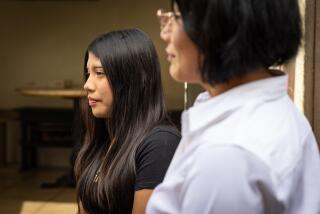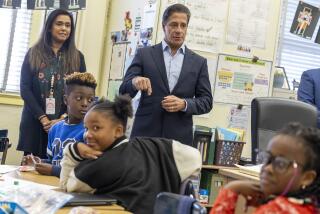Budget Deal Adds Day to School Year
- Share via
SACRAMENTO — In education parlance, they are known by the somewhat oxymoronic name “pupil-free days,” the eight days or so throughout each year when teachers go to school to hone their skills--and the kids stay home.
Regardless of how rewarding the training is for teachers--and there is some debate about that--the days cause headaches for working parents who have to find child care or take time off work.
More significant, they mean that students in many parts of California, including Los Angeles, spend less time in the classroom than youngsters almost anywhere else in the country--as few as 172 days. And the state’s students are even further disadvantaged when contrasted with their counterparts in Japan, South Korea and many European countries, who crack the books 240 days or more each year.
Recognizing that, legislators working on a state budget for 1997-98 tentatively agreed to spend a tiny fraction of the $34 billion devoted to kindergarten through 12th-grade education--or $50 million--to add one more teaching day to the school year statewide.
Written by state Sen. Steve Peace (D-El Cajon), the bill originally called for as many as eight more instructional days. Legislators are expected to take a final vote on the budget Tuesday.
State Supt. of Public Instruction Delaine Eastin, a Democrat who was a co-sponsor of Peace’s bill, said that--though modest in its final form--the legislation is a step in the right direction.
“It is increasingly apparent to everybody that the kids don’t go to school enough days,” she said. “I think the Legislature will . . . add more days in the coming years.”
Eastin’s goal is for the state to eventually fund 190 days of instruction and eight other days for which teachers would be paid to attend seminars, lectures and demonstrations on weekends or during school vacations. At $50 million a day, that plan would cost $850 million annually for the extra classroom time.
Gov. Pete Wilson, a Republican, also supports students spending more hours learning. During last week’s negotiations, his office proposed adding as many as six days to the class calendar.
“Our kids are just as bright [as children in Europe and Asia] but they are not getting the same [days of] education,” Wilson told a news conference Friday. “That is unfair to them, and it will make a difference in the future in terms of their employability.”
Though the Democrats had introduced the longer-year idea first, they balked at Wilson’s plan for funding an added six days. He proposed tapping into a $500-million pot that--under an agreement worked out a year ago with the California Teachers Assn.--was already spoken for.
Under that plan, whatever unanticipated money the state received from April’s tax filings would be spent equally on supplementing the budgets of some school districts--to bring their spending closer to the state average--and on making up for past shortfalls in education spending.
When that deal was worked out, it was thought the windfall might total $50 million. But the unexpectedly strong economy produced 10 times as much as had been believed likely.
Overall, public schools clearly will benefit from the new budget. In addition to the money for the extra teaching day, there are funds to pay for smaller classes--meaning 20 or fewer pupils--from kindergarten through third grade, $100 million for computers in high schools and $40 million for a new statewide standardized test, something many educators oppose.
Despite the agreement to add one day, it’s unclear when it will take effect. Calendars for the upcoming year, dictating which days teachers teach, have long since been negotiated between union locals and school districts.
So it could be 1998-99 before the day becomes a reality. And even when it does, some students will still go to school a week or more longer than others.
In general, the current range is between 172 days--in districts such as Riverside, Moreno Valley and Norwalk-La Mirada and some schools in Los Angeles--and 180 days in districts including Santa Ana, ABC Unified and San Francisco. A few districts have more than 180 days.
The statewide average for the 1995-96 school year was 176 days.
Some districts, mindful of the fact that instructional time is a key variable in how well students learn, had resisted the temptation to schedule all eight teacher training days.
The Garden Grove Unified School District had only a single day of state-paid staff development last year, meaning that students were in class 179 days.
“We do believe in staff development for teachers, but we have just believed that staff development should be provided outside the instruction time for students,” said Garden Grove Supt. Ronald Walter.
Although Peace’s bill only pays for one more teaching day, it adds momentum to a trend that has taken various forms across the state.
The South Bay Union Elementary School District in Imperial Beach near San Diego has, for the past several years, kept schools open 225 days--giving children the option of spending as many as 45 extra days in class. Vaughn Street 21st Century Learning Center in Pacoima, a charter school, operates for 200 days. Though students are only required to show up for 180 of those days, most are there for all of them.
Last year, the Legislature allocated $1.7 million for an experiment extending the academic year in Oxnard high schools by seven days, to 187.
More to Read
Get the L.A. Times Politics newsletter
Deeply reported insights into legislation, politics and policy from Sacramento, Washington and beyond. In your inbox twice per week.
You may occasionally receive promotional content from the Los Angeles Times.










